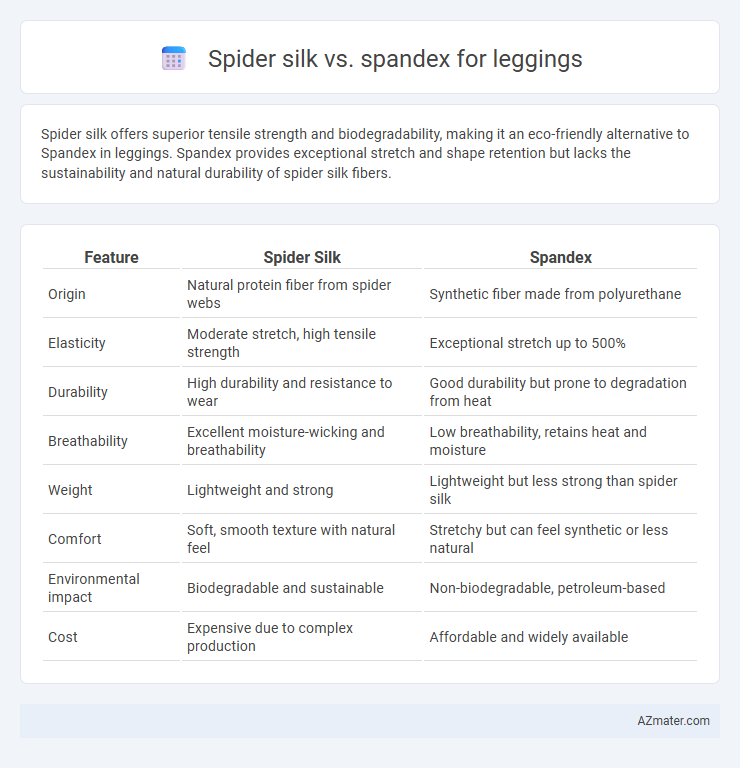Spider silk offers superior tensile strength and biodegradability, making it an eco-friendly alternative to Spandex in leggings. Spandex provides exceptional stretch and shape retention but lacks the sustainability and natural durability of spider silk fibers.
Table of Comparison
| Feature | Spider Silk | Spandex |
|---|---|---|
| Origin | Natural protein fiber from spider webs | Synthetic fiber made from polyurethane |
| Elasticity | Moderate stretch, high tensile strength | Exceptional stretch up to 500% |
| Durability | High durability and resistance to wear | Good durability but prone to degradation from heat |
| Breathability | Excellent moisture-wicking and breathability | Low breathability, retains heat and moisture |
| Weight | Lightweight and strong | Lightweight but less strong than spider silk |
| Comfort | Soft, smooth texture with natural feel | Stretchy but can feel synthetic or less natural |
| Environmental impact | Biodegradable and sustainable | Non-biodegradable, petroleum-based |
| Cost | Expensive due to complex production | Affordable and widely available |
Introduction to Spider Silk and Spandex
Spider silk is a natural protein fiber renowned for its exceptional strength, elasticity, and lightweight properties, making it an innovative material for high-performance leggings. Spandex, also known as elastane, is a synthetic fiber valued for its outstanding stretchability and shape retention, commonly used in activewear and compression garments. Comparing spider silk and spandex reveals distinct advantages in durability, comfort, and environmental impact for legging fabric choices.
Origins and Production Methods
Spider silk, a natural protein fiber produced by spiders through a complex spinning process involving specialized glands, offers exceptional tensile strength and elasticity due to its molecular structure. Spandex, a synthetic fiber made from polyurethane, undergoes a chemical synthesis process called segmented polymerization, enabling high stretchability and recovery in fabrics. While spider silk production is limited by natural constraints and labor-intensive extraction, spandex manufacturing is industrialized for mass production, making it more accessible for legging fabric applications.
Material Composition Comparison
Spider silk leggings utilize natural protein fibers known for exceptional tensile strength, elasticity, and moisture-wicking properties, offering superior breathability and durability. Spandex, composed of synthetic polyurethane-polyurea copolymers, delivers high stretchability and shape retention but can trap heat and moisture due to lower breathability. The choice between spider silk and spandex fabrics directly impacts comfort, performance, and environmental sustainability in activewear.
Strength and Durability
Spider silk legging fibers exhibit remarkable tensile strength, surpassing many synthetic materials and providing exceptional resistance to stretching and tearing. Spandex, although highly elastic and flexible, tends to lose durability over time due to repeated stretching and exposure to heat or sweat. The superior molecular structure of spider silk enhances longevity and maintains elasticity without compromising strength, making it an ideal choice for long-lasting, resilient activewear.
Flexibility and Stretchability
Spider silk offers superior flexibility and remarkable tensile strength, allowing leggings to stretch comfortably without losing shape or durability. Spandex excels in stretchability with its ability to expand up to 500%, providing exceptional elasticity and snug fit in activewear. Combining spider silk's resilience with spandex's elasticity results in leggings that maximize both comfort and performance under dynamic movements.
Comfort and Skin Sensitivity
Spider silk offers exceptional softness and breathability, making it highly comfortable and ideal for sensitive skin due to its natural hypoallergenic properties. Spandex provides excellent stretch and shape retention but can trap moisture and cause irritation for those with sensitive skin. Choosing spider silk leggings enhances comfort by reducing sweat buildup and minimizing skin irritation compared to synthetic spandex materials.
Moisture-Wicking and Breathability
Spider silk fabric exhibits excellent moisture-wicking properties and superior breathability compared to spandex, allowing better evaporation of sweat and keeping the skin dry during exercise. Spider silk's natural protein structure promotes airflow and temperature regulation, enhancing comfort for extended wear. Spandex, while stretchy and form-fitting, tends to retain heat and moisture, making it less effective for moisture management in leggings.
Environmental Impact and Sustainability
Spider silk offers exceptional biodegradability and low environmental impact due to its natural protein fibers, whereas Spandex is a synthetic polymer known for its persistence in landfills and reliance on fossil fuels. The production of spider silk, especially lab-engineered variants, requires fewer chemicals and generates less pollution compared to the energy-intensive manufacturing of Spandex. Choosing leggings made from spider silk supports sustainability by reducing microplastic pollution and promoting renewable material cycles.
Cost and Availability
Spider silk leggings offer exceptional strength and flexibility but come at a significantly higher cost due to the complex and labor-intensive production process. Spandex leggings are widely available and popular for their elasticity and affordability, making them a cost-effective choice for everyday wear. Limited commercial-scale spider silk production keeps its availability scarce, whereas spandex is mass-produced and easily accessible worldwide.
Future Innovations in Legging Materials
Spider silk, known for its exceptional tensile strength and biodegradability, offers promising advancements in legging materials by enhancing durability and sustainability, while Spandex provides unparalleled elasticity and shape retention essential for activewear performance. Future innovations aim to combine spider silk's natural resilience with bioengineered spandex variants to create leggings that deliver optimal comfort, moisture-wicking, and environmental benefits. Cutting-edge research in nanotechnology and synthetic biology is driving the development of hybrid fibers that could revolutionize legging fabrics with enhanced breathability, stretch, and eco-friendly properties.

Infographic: Spider silk vs Spandex for Legging
 azmater.com
azmater.com